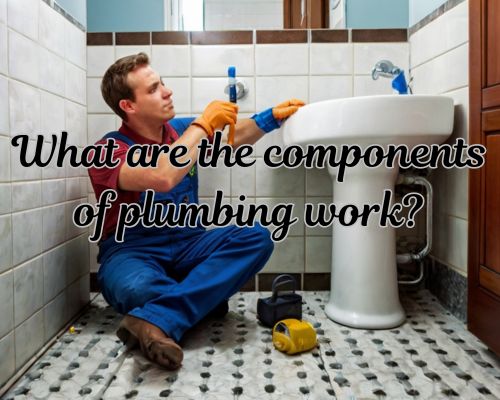
Essential Elements Explained
Plumbing work is an essential aspect of your home’s infrastructure, responsible for ensuring the smooth operation of water supply and waste removal.
The main components of a plumbing system include pipes, fixtures, and appliances that deliver clean water and remove wastewater efficiently.

These systems consist of various parts, such as water supply pipes, drainage pipes, taps, valves, and storage tanks.
Understanding these components is crucial for maintaining your plumbing system properly.
Water supply systems use pipes to transport clean water to fixtures like sinks and showers, while drainage systems remove wastewater through pipes, traps, and vents.
Fixtures and appliances are the end points where water is utilised, such as toilets, sinks, and washing machines.
Plumber Warragul highlights that each component plays a vital role in the overall functionality of your plumbing system. By familiarising yourself with these elements, you can better manage repairs and maintenance, ensuring a reliable water supply and efficient waste removal.
This knowledge not only helps in troubleshooting but also in making informed decisions when upgrading or installing new plumbing systems in your home.
Components of a Plumbing System
A home’s plumbing system involves a range of components working together to manage water supply, drainage, and wastewater disposal. It’s crucial to understand these elements to maintain an efficient and functional plumbing setup.
Piping and Fixtures
Pipes form the backbone of any plumbing system, guiding water to fixtures such as sinks, toilets, and bathtubs.
Common materials for residential piping include copper, PVC, PEX, and galvanised steel.
Copper is highly durable and resistant to corrosion, while PEX is flexible and easier to install. PVC pipes are cost-effective and often used for drainage.
Fixtures are the end points where water is used or disposed of and can vary in complexity and design.
Water Supply and Drainage
The water supply system brings clean water into your home, typically under pressure.
This water may come from a well or a municipal source and often includes a water meter and valves for control.
The drainage system removes wastewater through a network of pipes, leading to a sewer or septic system.
Proper design and installation ensure that water flows efficiently and contaminants don’t enter clean water lines. Regular maintenance and inspections are key to maintaining this balance.
Vents and Trapping Systems
Vents are crucial for maintaining air pressure within the plumbing system, preventing sewer gases from entering the home.
Vents also aid in the efficient draining of water.
Traps, typically found under sinks and bathtubs, retain a small amount of water to block gases from the sewer system.
Together, vents and traps ensure a healthy and odour-free environment by keeping harmful gases out and maintaining an even flow of wastewater.
Valves and Control Devices
Valves are essential for controlling and regulating water flow in the plumbing system.
They can shut off water during emergencies or routine maintenance.
Common types of valves include ball valves, gate valves, and pressure relief valves.
Control devices like thermostats in water heaters help maintain desired water temperatures.
Keeping these components in good working order ensures that your plumbing system operates smoothly and efficiently, mitigating potential issues before they escalate.
Plumbing Installation, Maintenance and Repair
Proper plumbing installation, regular maintenance, and timely repairs are essential for the efficient functioning of your home’s plumbing system. This ensures the seamless provision of potable water and effective wastewater management.
Routine Maintenance and Inspection
To keep your plumbing system in top shape, regular inspections are crucial.
Routine maintenance involves examining all pipes, fixtures, and appliances for signs of corrosion, leaks, and blockages.
Key areas to inspect include:
- Pipes: Check for wear and tear or leaks in copper, PVC, PEX, or galvanised steel pipes.
- Appliances: Inspect water heaters, dishwashers, and washing machines for proper operation.
- Fixtures: Look at sinks, toilets, and showers to ensure they are free of clogs and water damage.
Regular cleaning of drains and the use of strainers can help prevent grease and debris build-up, reducing the risk of blockages.
Common Repairs and Troubleshooting
Even with regular maintenance, you might still encounter plumbing issues that require immediate attention.
Common repairs include:
- Leaks: Locate and fix leaks in pipes, sinks, and toilets promptly to prevent water damage.
- Clogs: Use a plunger or specialised tools to clear blockages in drains and toilets.
- Heating Element Failures: Fix or replace the heating element in electric water heaters to maintain hot water supply.
Troubleshooting also involves checking for signs of appliance malfunction, such as unusual noises or inefficiencies, and repairing or replacing parts as needed. In emergencies, it’s often best to call a licensed plumber like Plumber Warragul.
Installation and Upgrades
Upgrading or installing new plumbing fixtures and systems can improve efficiency and comply with modern codes.
Common installations include:
- Water Heaters: Selecting energy-efficient models that extend the lifespan and reduce utility costs.
- Fixture Installation: Installing new sinks, toilets, and showers that align with design preferences and water-saving technologies.
- System Upgrades: Replacing old pipes with more durable materials like PEX or copper to meet current plumbing standards.
Make sure to comply with local plumbing codes when installing to avoid future issues. Also, a licensed plumber should handle the installation to guarantee functionality and safety.
Maintaining a proactive approach through regular maintenance, common repairs, and timely upgrades can ensure a reliable and efficient plumbing system in your home.





